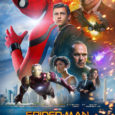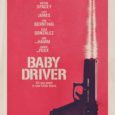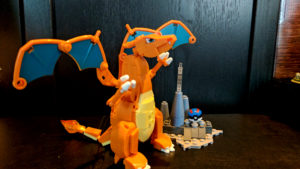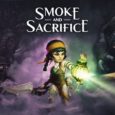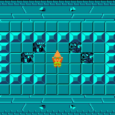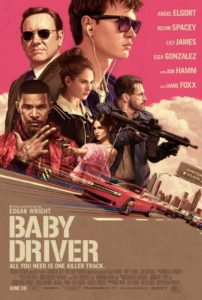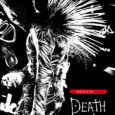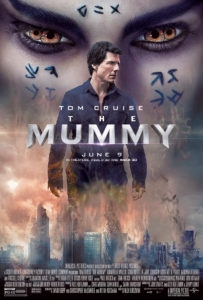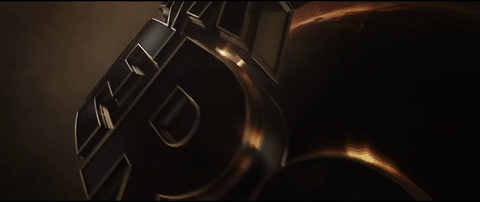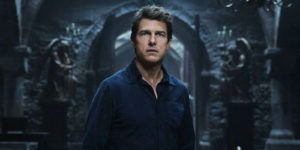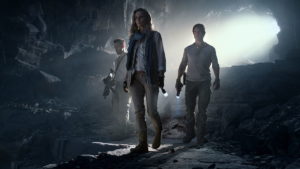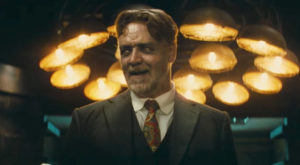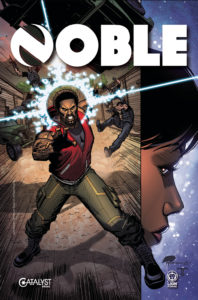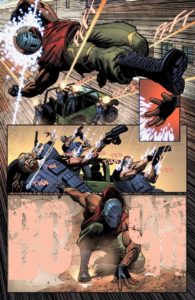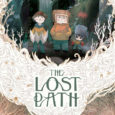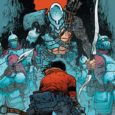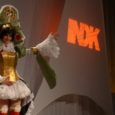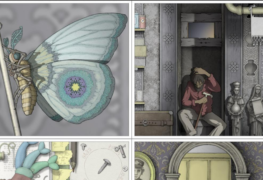 On Friday, Netflix dropped Death Note, a live-action film adaptation of the popular manga/anime of the same name. Since I was free for most of Sunday afternoon, with no plans besides counting down the hours until the seventh season finale of Game of Thrones, I figured I may as well check it out. After all, it was something I was looking forward to, despite the valid whitewashing criticism.
On Friday, Netflix dropped Death Note, a live-action film adaptation of the popular manga/anime of the same name. Since I was free for most of Sunday afternoon, with no plans besides counting down the hours until the seventh season finale of Game of Thrones, I figured I may as well check it out. After all, it was something I was looking forward to, despite the valid whitewashing criticism.
Before you read through my review, please keep in mind, I haven’t read the manga version of Death Note, nor watched a single episode of the anime series. I’m merely critiquing the Netflix movie on its own merits.
Also, while I’m not going to outright give away the ending, I do make references to certain plot points of the film, which may be spoilers for anyone who hasn’t seen it yet. So proceed with caution.
Death Note focuses on Light Turner, a smart high school kid who doesn’t seem to have any friends. His mother was recently killed, leaving just him and his cop father, a dynamic which causes a rift in their relationship. His mother’s killer walked away from the charges and Light doesn’t feel his father pursued the killer hard enough. One day, during a freak storm, Light finds a notebook, the Death Note, which grants the user the ability to kill anyone whose name is written on its pages. There are a bunch of rules associated with the Death Note but it all boils down to “killer notebook.”
Along with his girlfriend Mia, Light (I can’t believe this is the kid’s name) goes on a killing spree. They target bad guys and people who hurt others in an effort to “better the world.” In the process of their murders, they attribute the killings to a karma god of sorts, whom they name Kira, as a way to strike terror into the hearts of evil-doers.
 The murders attract the attention of L, an eccentric detective who is fueled by candy and often forgets to sleep. Being a sugar addict seems like an odd character trait to give a prominent character so I assume that this was a carry-over from the source material, but it really seems out of place. The film tried to explain it with an off-hand remark about the “insulin rush” but the trait doesn’t seem natural. In a long form narrative, like the manga or the anime, a quirk like this can developed and also used as a detriment to the character, such as when he’s in a situation lacking sugar. The movie, however, just shoehorns it in with very little (if any) explanation, so it comes off as silly.
The murders attract the attention of L, an eccentric detective who is fueled by candy and often forgets to sleep. Being a sugar addict seems like an odd character trait to give a prominent character so I assume that this was a carry-over from the source material, but it really seems out of place. The film tried to explain it with an off-hand remark about the “insulin rush” but the trait doesn’t seem natural. In a long form narrative, like the manga or the anime, a quirk like this can developed and also used as a detriment to the character, such as when he’s in a situation lacking sugar. The movie, however, just shoehorns it in with very little (if any) explanation, so it comes off as silly.
Then there’s Mia, Light’s girlfriend. She’s the guiding force in Light’s usage of the Death Note, a girl with a dark side that she hides from the rest of the world… except the movie makes the audience aware that she is the “bad girl” from the minute we first see her. She’s smoking a cigarette at cheerleading practice, for example, so clearly she’s edgy. The problem is that Mia has no depth. We never get a glimpse at her past, or at her home life to really understand why she’s so messed up. She is 100% gung-ho about using the Death Note, to the point of threatening Light’s life to convince him to give it to her but it’s never clear why. She’s deeply disturbed and would make for a fascinating character study, but unfortunately she’s used as a side note, only meant to push Light further and further to see how far he’ll go.
My main problem with the film is how easily all of the characters accept the idea of the supernatural being involved in the murders. Light’s cop father wastes no time coming to the conclusion that his son is Kira despite the physical impossibility for him to be so. Even L, with all his grand detective skills, fingers Light early on as the culprit, assuming he has some sort of latent telepathic abilities that allow him to control and kill people.
This wouldn’t be a big deal if the movie established itself as part of a world where this sort of this was commonplace. A few references to some of L’s past cases that document criminals with telepathy or whatnot would go a long way here. From everything we’re shown, however, the viewer has to assume that the film takes place in our world where the laws of physics apply. Yes, Light has a magic book that can kill people but that’s the outlier, not the natural order. If L had been shown to be chasing this book for a decade and realized that it found its way into Light’s hands, his deductions would make sense. But L, from what we’re shown, doesn’t know about the book’s existence and still manages to guess almost every rule. It’s implausible and makes the movie hokey.
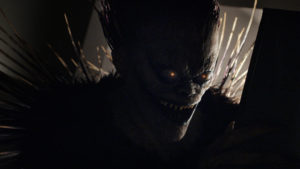 I also had a really difficult time figuring out who I should be rooting for. We get why Light has a hard time with life: his mother is killed, her killer buys himself out of a prison sentence, and he has to deal with bullies at school. So when he gets the Death Note and he’s able to turn everything around, his first act is to kill a classmate. It’s a little out there and doesn’t do much to establish himself as a “good guy.” When it comes to L, the guy who is trying to find justice and stop these murders, we never really connect with him. He is so quirky and abstract that it’s hard to find common ground, so despite his intentions, we don’t really care if he wins or not. It isn’t until he suffers a major loss do we see him exhibit any kind of emotion, and by then it’s too late into the film for the audience to really connect with the character.
I also had a really difficult time figuring out who I should be rooting for. We get why Light has a hard time with life: his mother is killed, her killer buys himself out of a prison sentence, and he has to deal with bullies at school. So when he gets the Death Note and he’s able to turn everything around, his first act is to kill a classmate. It’s a little out there and doesn’t do much to establish himself as a “good guy.” When it comes to L, the guy who is trying to find justice and stop these murders, we never really connect with him. He is so quirky and abstract that it’s hard to find common ground, so despite his intentions, we don’t really care if he wins or not. It isn’t until he suffers a major loss do we see him exhibit any kind of emotion, and by then it’s too late into the film for the audience to really connect with the character.
So who do we root for? The down-on-his-luck killer or the eccentric detective?
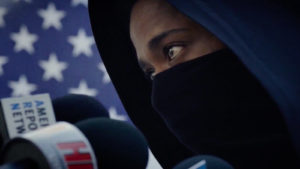 Death Note was directed by Adam Wingard, who is best known for V/H/S and for surprising everyone in 2016 with a new Blair Witch movie. I like Wingard as a director but he seemed to miss the mark with Death Note. The movie is remarkably directed and looks fantastic but really suffers from all of the logical and character inconsistencies in the script. I feel like there was definitely the possibility of a good movie, especially given the depth of the source material, but lacked the proper execution.
Death Note was directed by Adam Wingard, who is best known for V/H/S and for surprising everyone in 2016 with a new Blair Witch movie. I like Wingard as a director but he seemed to miss the mark with Death Note. The movie is remarkably directed and looks fantastic but really suffers from all of the logical and character inconsistencies in the script. I feel like there was definitely the possibility of a good movie, especially given the depth of the source material, but lacked the proper execution.
The cast did a great job with what they were given. Nat Wolff, who played Light, really felt like a lost, angry child, mad at the world for everything that happened to him. Wolff brought a lot of energy and emotion to the role and makes the character likeable despite the terrible things he does. Juxtaposed with that, Lakeith Stanfield as L made a great foil. His delivery as the stoic, brilliant detective drew that divide between the character and the audience, which made it so effective when the character hit his emotional breaking point. As a viewer, I felt his sadness and his rage, and enjoyed the way this emotion mirrored Light’s own, making them two sides of the same coin, of sorts.
 Even Margaret Qualley was fantastic as Mia. Though the character has the least depth of the cast, she’s a driving force to the story. Qualley plays the role with a certain coolness, almost emotionless. It makes the audience wonder if our opinion of the character is wrong or if she truly is a sociopath. Which is a great take considering how little backstory we get of the character.
Even Margaret Qualley was fantastic as Mia. Though the character has the least depth of the cast, she’s a driving force to the story. Qualley plays the role with a certain coolness, almost emotionless. It makes the audience wonder if our opinion of the character is wrong or if she truly is a sociopath. Which is a great take considering how little backstory we get of the character.
One of the highlights of Death Note, though, was Willem Dafoe as the voice of the demon Ryuk. Dafoe never shows up on screen but he brings life, ironically, to the death demon. His performance is reminiscent of his take on the Green Goblin in 2000’s Spider-Man, which I liked. He added a lot to a character that spends most of the movie shrouded in shadows and gives the audience something to grasp.
A Death Note film like this was a huge undertaking, considering it needed to boil down 37 episodes of the source anime into a 100 minute feature. Despite its missteps, the cast and crew did the best they could, unfortunately that didn’t make for a wholly great finished project. It’s the kind of movie to watch on a lazy weekend, or when you’re home sick hopped up on Nyquil. While it captures the dichotomy of doing bad things for good reasons, it doesn’t really explore those themes and just comes off as a superficial revenge story. Though I really did enjoy the final scene and the open-ended finale, I feel like all I really got out of this movie is the desire to watch the anime in the hopes of finding a good, complete story.
Grade: C
The other day I stopped into my local GameStop to see if they had any of the San Diego Comic Con exclusive Funko Pop!s available. What I discovered when I walked in, however, was much more exciting. Recently, Mega Construx released a line of Pokémon-themed building block sets. Being the Pokémon fan that I am I was at first embarrassed that this line had completely flown under my radar when it was announced back in February, but at least stumbling on them the way I did was validating.
There were about twelve sets in total, roughly six larger boxed sets and six little minifigs sort of that come in a Pokéball. I bought a little Eevee Pokéball on the spot. I figured I’d get one of the small ones to dip my toe in a bit, see how I like them. When I got home, it took me about ten minutes to put together (which really only took that long because I kept dropping all the pieces.) Once the figure was complete, I was hooked. At first it looked a little janky with the thick little legs and awkward tuft of fur on its chest but eventually all that became part of its charm.
A couple of days later I went back to the store and pored over which of the larger sets to buy. What I like most about the line is there are a few different themes; besides the smaller figures, a couple of the larger Pokémon are represented, like Charizard and Gyarados. The line also includes the starter mid-evolutions, Charmeleon, Wartortle and Ivysaur as their own stand-alone sets. Each of the starters, Charmander, Squirtle and Bulbasaur, along with Pikachu are paired off for battle scene building sets.
After much, much deliberation, I decided to go with Charizard. I also picked up Abra and Magikarp, a couple of my favorites, from the line of smaller sets so I can display next to little Eevee.
Again, the little ones were quick to assemble; total time for both of those was about fifteen minutes. Charizard, on the other hand, took roughly an hour to build. The build instructions were slightly confusing as the way they’re drawn isn’t as clear as what you’d get from a LEGO manual. I managed, though, and I’m really proud of myself.
I’m also really proud of this Charizard, which turned out to be a nice display piece. A lot of the articulation is really good, especially around the head, legs and tail. I would have liked if there was a bit more articulation, like maybe if the arms moved a little better and get some moveable fingers and jaw in there but I also realize that those features would impact the price, which may turn off a few potential fans.
As far as quality, it’s easy to tell why LEGO is the cream of the crop. That’s not to say Mega Construx are bad; in fact, they’re intricately designed and really capture the likenesses of the Pokémon they’re meant to replicate. However, the building aspect of the set was difficult at times. I found myself struggling to click blocks in place, having to rely on using my teeth to get the amount of pressure that I needed. This could have been due to some microscopic defect in the stud that made it just too big to fit. In fairness, though, it could have just been small parts and sweaty hands (it was a really hot day, you guys.)
If you do manage to get them clicked into place and realize you put the piece in the wrong spot, good luck getting it apart. Unlike LEGO, Construx don’t come with a handy separating tool so, once again, I lucked out that I had a mouthful of teeth to do the job. In fairness, though, I don’t fault Construx for this. It took LEGO years to realize a tool like this was a necessity and since they likely have a patent on it, Construx will need to design their own.
As I mentioned earlier, in addition to the larger sets, the series offers a few single figures, such as Pokémon’s mascot, Pikachu, and a few other fan favorites, like Eevee, Magikarp, and…Zubat. What I like most about these are the packaging; they all come in a plastic Pokéball that can be used as a display base once building is complete. And at around $7 each, they’re a pretty good deal. Considering LEGO minifigure blind bags can retail for right around $5 and only have about 5 pieces each and a substandard display, these Pokémon characters are basically a steal.
Even the larger sets are a good value. At this time, the biggest set was Gyarados, with a total of 352 pieces retailing for $30. Compared to some of LEGO’s franchised sets, that’s an amazing deal. The LEGO Batman Movie Riddler Riddle Racer playset has 254 pieces and is regularly priced at $35 (though was on sale for $24 at the time of this writing, for whatever that’s worth).

Then again, you get what you pay for. With LEGO being the Cadillac of building blocks, the Pokémon Mega Construx don’t size up to quite that level. Sure, the models are well done and really capture the likenesses of the Pokémon, but the builds aren’t as sophisticated as what one would expect from LEGO.
It was a great choice for Mega Construx to jump into the Pokémon arena, especially given the mainstream popularity of Pokémon GO. Building sets like these now appeal to a wider audience since they are familiar with the characters. Even though they aren’t perfect, they are fantastically modelled and offer great playability.
Bottom line: I want more. Not just “I want to buy more sets,” which is definitely true. The low price point and great showcaseability really make these sets a good value despite their shortcomings. When I say I want “more,” I mean more sets. I want this line to do well so that Mega releases additional sets, like maybe the Generation 1 legendaries, Articuno, Zapdos, Moltres, and Mewtwo. Even a tiny little Mew hovering over a Pokéball would be sweet.
Also, I want to see some from the later generations of games: Tyranitar, Hoot Hoot, Lucario. There are so many great Pokémon that would make amazing display pieces that this could go on forever…just like the games!
Each January, I make a list of the movies that I want to see that coming year. It’s usually filled with big-budget, over-blown action flicks, because that’s what I like. This year, I had to revise my list a couple of times because I overlooked a few items that should appeal to me. One of those revisions included Baby Driver. At first glance, I wasn’t too sure about the Edgar Wright penned and directed flick but I decided to give it a shot. I’m glad I did.
Ansel Elgort is Baby, the film’s protagonist. A perfectly apropos nickname given his youthful looks, but “Baby” is all audiences know the character by throughout most of the movie. Nicknames are also a recurring trend in the movie, in which a team of thieves are gathered by the mysterious Doc (Kevin Spacey) to pull off complex heists. Think the Avengers, but they steal stuff and don’t have super powers.
The plot of the movie is thin by most standards; Baby is in for “one last job” before leaving his life of crime behind him. Naturally, the plan goes off the rails and all hell breaks loose, leaving Baby to adapt if he wants to survive and live his happily ever after.
Edgar Wright is a director who manages to put his own spin on different film genres. He breathed new life into zombie movies with Shaun of the Dead and made a legitimately fun comic book flick with Scott Pilgrim vs the World. It’s easy to expect Wright to deliver a fast-paced yet super fun heist movie, which he manages to do.
Despite the weak plot, the movie is a blast, mostly because of the characters that Wright has created. We have Baby, deep and mysterious and into a wide range of music to which he has an unnatural attachment. The audience is only allowed brief glimpses into his past, but it’s enough to puzzle together why he is the way he is. We’re also given an expository explanation as to his need for music at all times, which is delivered in a delightfully clever way by Mr. Spacey himself.
Then you have Bats, played by Jamie Foxx. “Bats” is short for “Bat-Shit,” indicating how crazy the character is. We’re given nothing about Bats’s past, yet Foxx’s portrayal of the character intimates just how deep his psychoses run. Foxx is great in this role and makes it really easy for audiences to hate him.
Then there’s John Hamm’s Buddy. An enigma for most of the film, it’s hard to gauge which way Buddy goes. He’s a bank robber, sure, but he’s also the only one who’s ever shown Baby any respect. Hamm imbues Buddy with a dead-eyed stare and cool charisma that makes him look like he was ripped right out of a Tarantino film, which makes him a perfect fit for the world of Baby Driver.
With how much we give credit to Edgar Wright for his direction and the actors for their delivery, we also need to recognize the editors, Jonathan Amos and Paul Machliss. I’m sure much of the film kept with Wright’s vision, but Amos and Machliss cut it so that it gels perfectly. A lot of the fun of the movie is within the action sequences, where the gunshots and sound effects sync up with the film’s soundtrack. It’s subtle at first; you almost don’t realize it’s happening but when you do, it adds depth to the scenes.
Speaking of the music, I can’t ignore the soundtrack as it’s an important element of the film. The song selections work brilliantly with the on-screen actions. Similar to the way Guardians of the Galaxy Vol. 2 handled its own musical numbers, Baby Drivers takes innocuous song choices and pairs them with intense, frenetic action. A tire-screeching police chase set to “Bellbottoms” by The Jon Spencer Blues Explosion? It works. An explosive gun fight in a dirty warehouse with Button Down Brass’s “Tequila” as the back drop? Flawless. (The soundtrack also features Ducky from NCIS and I never thought I’d type that sentence but here I am.)
There’s more to Baby Driver than just cool characters and an OK plot; it’s a movie that delivers an experience. From the very start, and I mean at the start of the vanity logos, the film includes a low level hum, just like the one Baby hears from his tinnitus. It accompanies almost all of the moments that aren’t occupied by music or explosions and is persistent throughout, making the audience feel just like Baby does. Sometimes it’s noticeable, sometimes it isn’t. Either way, we get a better idea of how Baby hears his world.
Baby Driver isn’t perfect, though. Baby’s world is turned around when he meets a pretty, perky waitress named Debora (Lily James). Debora’s goal is to cut and run out of town, a goal that Baby doesn’t realize he has until he meets her. James is lovely in the role but her part just runs flat. We get some back story into her character but it’s nothing of any significance. She has a whirlwind romance with Baby but she doesn’t actually change him in any way. We’ve already seen that he has a conscience despite what he does for a living; all Debora does is make him want to run away from the life he built in Atlanta.
It’s a weird dynamic, in a way, considering the relationship Wright shows us between Baby and his foster father, Joe (CJ Jones). Joe is deaf and uses a wheelchair, casting Baby in the caregiver role. Their relationship is so natural and authentic that I would find Joe a more believable reason for Baby to escape the world that he’s entrenched in. I guess you just can’t beat a pretty girl when it comes to movie tropes.
Leaving aside the stale plotline and few shallow characters, Baby Driver is a remarkable film. It’s a fun, upbeat romp in a summer overloaded with drab, ennui-filled popcorn flicks.
Grade: A-
When Iron Man debuted in theaters in 2008, audiences had no idea that it would completely change the landscape of film-making forever. It marked the birth of the Marvel Cinematic Universe. The MCU became a collection of movies featuring different characters all tied together as a way to multiply audience interest and profits for otherwise uninteresting movies. While Marvel pioneered the scheme, other studios quickly jumped on board, notably Marvel’s main competitor, DC Comics. Universal Pictures recently decided to dust off their “Monsters” properties and build their own Cinematic Universe. The Mummy marks the first film in what they’ve christened “Dark Universe.” But the question remains; is The Mummy worthwhile?
From the very start, Universal wanted to make sure audiences were aware that The Mummy is part of a larger framework. With press releases and announcements of Johnny Depp playing the Invisible Man, this felt unnecessary. The studio has even inserted a logo variation that morphs the famous “Universal Pictures” vanity logo into the words “Dark Universe,” almost like a new entity that produced the movie. It’s an odd addition, one done out of hubris more than anything else, and it’s completely ridiculous. It would be as if Iron Man began with a logo touting it as “A Marvel Cinematic Film.”
The film itself opens in an equally bizarre way: on the burial of a Templar Knight in twelfth century England. It then quickly transitions to modern-day London before flashing back to Egypt and summarizing the history of Ahmanet and her quest for power, all told through a narration by Russell Crowe’s character. Why any of this was necessary I can’t say. The only thing I can think of is that the film’s writers, of which there are six, had no faith that audiences would have been able to understand the hook without having it spelled out. That theory also explains the immense amount of verbal exposition we get along the way. For a film that’s as steeped in lore as The Mummy, I would expect an excess of expository dialogue, but Universal really took advantage of my expectations.
Most of the film gets bogged down from how hard it is to like Tom Cruise’s character. Nick…Something Or Other is an Army Sergeant/thief who has his sights set on “liberating” whatever valuables he happens to find in modern-day Iraq. He makes no excuses for his deception and his main motivation throughout the film is saving himself. There’s a slight glimmer of goodness in his character, which is dashed as quickly as it appears by way of a sad attempt at levity. I doubt the writers even realized that their throw-away joke negated any positive quality in the character, because if they did, they should have worked harder to make him more likeable.
The dislike of Cruise’s character is compounded by how terribly the writers treat his female counterpart. Nick takes advantage of archeologist Jenny Halsey (Annabelle Wallis) by lying to her, sleeping with her, and stealing her map to the location of what he believe is “treasure,” but not once does he show remorse for his actions. However, when he later discovers her secret that she’s been working with a covert team of “archeologists,” she’s made to feel terrible for her actions and apologizes profusely. Even watching this through the eyes of a dude, I could see the incongruity plain as day.
As expected, the movie makes a number of humorous attempts through its big, loud action sequence but most of them are so trite and obvious that they fall flat. Not to mention that some of the biggest jokes happen at the most inopportune moment, which made it uncomfortable to even enjoy them.
The humor was another pratfall the movie continued to make. Many of the jokes happen with unfortunate timing, such as when danger was at its highest. This created a strange juxtaposition that felt awkward. Am I supposed to laugh as Tom Cruise is about to get a dagger plunged into his heart? According to the writers, yes, I am.
I can’t say that the film is entirely bad, though. It does a few things right, most notably the casting of Sofia Boutella as the titular Mummy. Boutella has an amazing onscreen presence. The way she plays Ahmanet is threatening, unrelenting, and imposing, but she also manages to ply sympathy when needed. The only downside is how much her talent is wasted on a one-note villain. Granted, Ahmanet has more depth than both Cruise’s and Wallis’s characters, but her antagonism just comes off as boring. She’s the ultimate unstoppable evil that can be easily stopped by a MacGuffin.
Then you have Russell Crowe, whose appearance in this film is solely to expand the Dark Universe. Crowe plays Dr. Henry Jekyll. Yep, that Dr. Jekyll. He was a joy to watch as he seemed to be the only person in the ensemble who bothered getting into character. While I did like the way the film introduced the Jekyll/Hyde connection, I feel like they overdid it. In a case like this, as most of Marvel’s films have shown, a little goes a long way. Universal, on the other hand, didn’t seem to trust their audience would get the allusion and needed to center an entire action scene on just how badass Mr. Hyde could be. While it was a fun scene, it slowed down the pacing of the film and took some of the spotlight away from the Mummy, who should have always been the focus of the film.
For a movie that’s meant to kickstart a cinematic universe full of classic monsters, The Mummy lacks any sort of horror or thrills. It’s overflowing with cheap jump scares and cringe inducing creepiness (like Cruise being covered in rats), and those grow old fast. It also lacks the charm that 1999’s The Mummy starring Brendan Fraser had. At this point, it must be asked: what is this Mummy flick supposed to bring to the table, besides over-the-top action pieces?
Would I say The Mummy was a good movie? Nope. I will say that as the tent pole of the “Dark Universe,” it was fun, and at the very least, it opened the doors for films featuring a more diverse cast of classic monsters. After years of countless Dracula, Frankenstein and Werewolf movies, we finally have the chance to gets movies centered on the Hunchback of Notre Dame, Dr. Jekyll and Mr. Hyde, and the Invisible Man. In the hands of the right writer and director, these movies have the opportunity to be mind-blowing. While The Mummy is mediocre at best, it deserves some credit.
Grade: C
As one of the smaller independent presses, Lion Forge Comics is not very well known. Most of their line up consists of comics based on popular 80s franchises (as well as a few not-so-popular). As of recently, though, they are jumping into the super hero game, starting with the release of Catalyst Prime: Noble, a prelude to their upcoming Catalyst Prime universe.
The premise behind Catalyst Prime is that a massive asteroid is heading to Earth and only 5 astronauts are able to stop it. It’s a fairly straight forward premise, one that leaves a lot of room to work with. We’ll learn more about what they’re calling “The Event” on Free Comic Book Day when Lion Forge gives out copies of Catalyst Prime: The Event. From there, the Catalyst Prime universe will slowly unfold in seven monthly comic books. One of these is Catalyst Prime: Noble, which focuses on David Powell, one of the astronauts involved in The Event and what becomes of him in the following year.
The main cast of Noble is only two characters, the aforementioned David and his wife, Astrid. Writer Brandon Thomas was wise to structure the introductory chapter like this as it made it easy to follow. Being new characters, we don’t know much about the kind of people David and Astrid are, so throwing a wide cast at new audiences may become confusing and alienate readers. By paring that down to two, especially two who are so closely tied together, Thomas create a far simpler reading experience while getting the most out of the story.
Most of the issue focuses on David, who has no idea who he is but shows some powerful telekinetic abilities, being pursued by a specialized military team. Everything is left ambiguous; we don’t know why David’s on the run, why these men are chasing him, or who the mysterious “she” is that sent them. It’s a well written, well paced scene that’s enhanced by Roger Robinson’s art.
What I like most about the art is Robinson’s style. He uses a lot of lines, most especially in his figures and when indicating motion. It’s very different from a lot of the more mainstream comics and lends the book a gritty feeling. I use “gritty” as it’s supposed to mean; coarse and dirty, not dark and broody as it’s become to be known. Which I mean as a compliment. The scene involved David being chased by a group of large men through a sandy, desert town. One word that should be used to describe this is “gritty.”
The panel progression is very cinematic. From the very first page we get a slow zoom out from Astrid’s wedding ring as she sits nervously in a waiting room. This transitions to a flashback of not long before, revealing the reason she’s nervous. That lasts less than a page before we return to the present moment, when Astrid is given terrible news and breaks down in tears. Three pages is all it takes to recap her harrowing experience losing her husband in The Event and it’s all that’s needed. Wonderful work by both Thomas and Robinson.
I also loved the end twist. It’s a pretty big reveal that most writers would dangle in front of readers, dropping little clues here and there through subsequent issues in order to keep them on the hook. But Thomas tells us up front at the end of the issue who is masterminding the hunt for David. It’s a great reveal because it opens so many more questions that entice readers to come back without resorting to clichés and cheap tricks.
As a fan of super heroes, it’s nice to break away from the worlds of Marvel and DC, which are steeped in so much history that it’s often difficult to keep up. Catalyst Prime offers a reprieve from that, with strong characters that we get to see evolve and grow in real time. It’s also great to see a comic so deftly blend the techniques of filmmaking into its storytelling. I hadn’t heard much about Catalyst Prime before reading Noble but now I’m definitely looking to go deeper into the universe.
Grade: B
PaxSouth is a hub for intriguing and inventive games, and the first two video games from movie studio, Annapurna Pictures, are no exception.
Gorogoa
Gorogoa caught my eye firstly because of the art. It looked like a coloring book brought to life, like a dream you could wade through via computer. I spent a solid half hour diving into the story, figuring out some puzzles with lightning speed and stumbling through others while feeling judged by the character when I got stuck. That said, I can’t wait to get my hands on the entire game!
Designed, developed, and illustrated by Jason Roberts, Gorogoa is a completely unique game. The overall story is equal parts myth and magic as a boy sees a colossal monstrosity in his city and decides to unlock the secrets to finding it. Each gorgeous scene is split into four panels that you can explore through a simple point and click mechanic. Solving each puzzle reveals more of the story. Elegantly simple and perfect for fans enamored of lovely storytelling.
Gorogoa is scheduled to hit mobile devices and Steam in Spring 2017.
What Remains of Edith Finch

I adore morbid games, and when I saw that What Remains of Edith Finch ‘s premise revolves around about different characters dying, I immediately signed up to demo What Remains of Edith Finch.
What Remains of Edith Finch is a collection of short tales about a family in Washington state. As Edith, the player will explore the colossal Finch house, searching for stories. Each story you find lets you experience the life of a new family member on the day of their death, with stories ranging from the distant past to the present day, and culminating with that family member’s death.
In the 20 minute demo, we experienced the final moments of two different family members. The macabre interactive narrative is completely fresh in its storytelling and the attention to detail reminds the player that this title isn’t suited to the run-and-gun. I don’t want to spoil anything for those of you picking it up, but prepare yourself for some feelings. Oh, and remember to breathe.
What Remains of Edith Finch is due out Spring 2017 on Steam and PS4. Check back here, because this is the standout title that we absolutely cannot wait to get our grubby little hands on and review in depth!
Want more PAX South 2017 coverage? All you had to do was ask!
Prisma and The Masquerade Menace, Sundered, and RiME
Minit, Beat Cop, and Strikers Edge
Arms, Splatoon 2, and Legend of Zelda: Breath of the Wild
Monster Boy, Warlock’s Tower, and Has-Been Heroes







